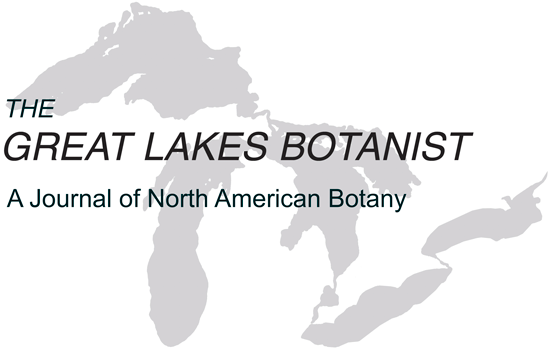ï~~2005
THE MICHIGAN BOTANIST
137
brid swarms of Juniperus virginiana and Juniperus horizontalis. Bulletin of the Torrey Botanical
Club 72: 379-384.
Fassett, N. C. 1951. Grasses of Wisconsin. Madison, Wisconsin: University of Wisconsin Press.
Fassett, N. C. and B. Calhoun. 1952. Introgression between Typha latifolia and Typha angustifolia.
Evolution 6: 367-379.
Furley, P.A., J. Proctor, and J. A. Ratter (Editors). 1992. Nature and Dynamics of Forest-Savanna
Boundaries. London: Chapman and Hall.
Gosz, J.R. 1993. Ecotone hierarchies. Ecological Applications 3: 369-376.
Greene, C. W. 1935. The distribution of Wisconsin fishes. Madison, Wisconsin: Wisconsin Conservation Commission.
Griggs, R. F. 1914. Observations on the behavior of some species at the edges of their ranges. Bulletin of the Torrey Botanical Club 41: 25-49.
Hagen, J. B. 1992. An Entangled Bank: The Origins of Ecosystem Ecology. New Brunswick, New
Jersey: Rutgers University Press.
Hansen, A. J. aand F. Di Castri, eds. 1992. Landscape Boundaries: Consequences for Biotic Diversity and Ecological Flows. New York: Springer-Verlag.
Holland, M. M., P. G. Risser, and R. J. Naiman, eds. 1991. Ecotones. The Role of Landscape Boundaries in the Management and Restoration of Changing Environments. New York: Chapman and
Hall.
Johnston, C. A., J. Pastor and G. Pinay. 1992. Quantitative methods for studying landscape boundaries. In Landscape Boundaries: Consequences for Biotic Diversity and Ecological Flows. (A. J.
Hansen and F. di Castri, eds.), pp. 107-128. New York: Springer-Verlag.
Knapp, J. G. 1871a. The isothermal lines of Wisconsin. Transactions of the Wisconsin State Horticultural Society 1: 177-198.
Knapp, J. G. 1871b. The native vegetation of Wisconsin. Transactions of the Wisconsin State Horticultural Society 1: 119-125.
Krebs, C. J. 1994. Ecology (Fourth Edition). New York: Harper and Row.
Livingston, B. E. 1903. The distribution of the upland plant societies of Kent County, Michigan.
Botanical Gazette 35: 36-55.
MacMillan, C. 1892. The Metaspermae of the Minnesota Valley: a list of the higher seed-producing
plants indigenous to the drainage-basin of the Minnesota River. Minneapolis, Minnesota: Harrison
& Smith, State Printers.
MacMillan, C. 1893. The probable physiognomy of the cretaceous plant population. The American
Naturalist 27: 336-345.
MacMillan, C. 1899. Minnesota Plant Life. Report of the Survey Botanical Series III. Saint Paul,
Minnesota: Pioneer Press.
McCann, M. T. 1979. The Plant Tension Zone in Michigan. Western Michigan University, Kalamzoo, Michigan. Master of Arts Thesis.
McIntosh, R. P. 1967. The continuum concept of vegetation. Botanical Review 33: 130-187.
McIntosh, R. P. 1976. Ecology since 1900. In Issues and Ideas in America (B. J. Taylor and T. J.
White, eds.), pp. 353-372. Norman, Oklahoma: University of Oklahoma Press.
McIntosh, R. P. 1985. The Background of Ecology: Concept and Theory. Cambridge: Cambridge
University Press.
Merriam, C. H. 1894. Laws of temperature control of the geographic distribution of terrestrial plants
and animals. National Geographic Magazine 6: 229-238.
Merriam, C. H. 1898. Life zones and crop zones. U.S. Department of Agriculture Biological Survey
Bulletin 10: 1-79.
Merriam, G. & J. Wegner. 1992. Local extinctions, habitat fragmentation, and ecotones. In Landscape Boundaries: Consequences for Biotic Diversity and Ecological Flows (Hansen, A. J. and F.
Di Castri, eds.), pp. 150-169. New York: Springer-Verlag.
Merriam-Webster's Collegiate Dictionary. 1993. Springfield, Massachusetts: Merriam-Webster.
Potzger, J. E. 1946. A pollen study in the tension zone of Lower Michigan. Butler University Botanical Studies 8: 161-177.
Pound, R. And F. E. Clements. 1897. Review of "Observations on the Distribution of Plants along
the Shore at Lake of the Woods." American Naturalist 31: 980-984.
Resinger, H. and J. M. Gomez Gutierrez (compilers). 1992. Elsevier's Dictionary of Terrestrial Plant
Ecology: English-Spanish and Spanish-English. Amsterdam: Elsevier.
0


